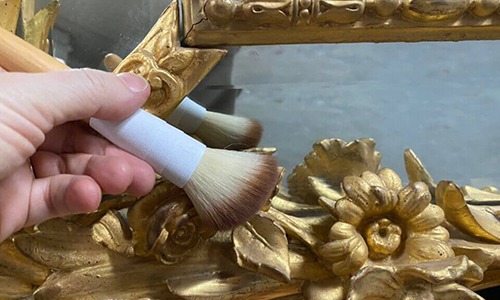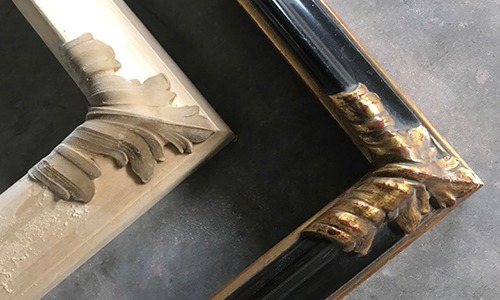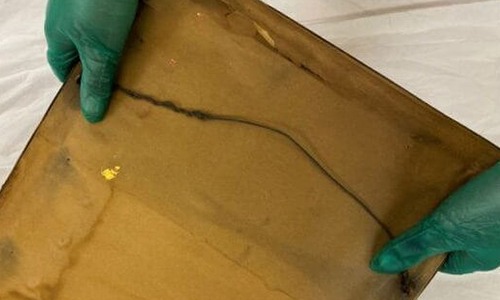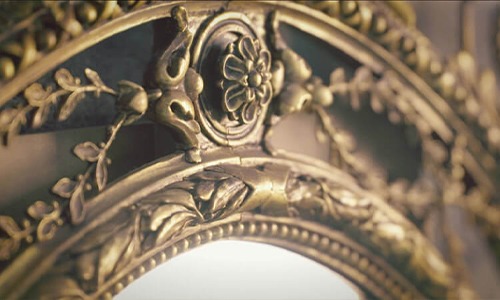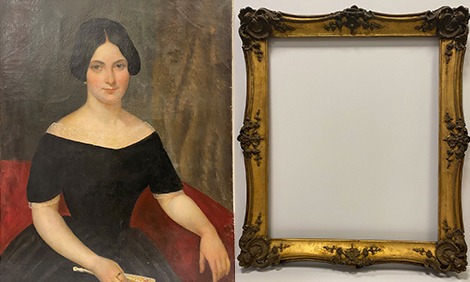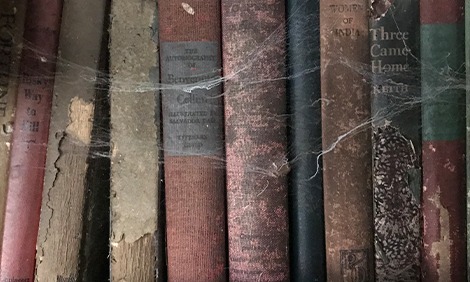Emergency Care
Insect Infestation
In Wooden Artifacts, Frames and Furniture
By April Hann Lanford
Insect Infestation in Wooden Artifacts, Frames and Furniture
By April Hann Lanford
You might be surprised, but a common attribute among aged wooden artifacts is the evidence of previous insect activity. While not all antique pieces will have this, don’t be alarmed if they do. The appearance of such activity is also even mimicked in reproductions to give a piece the appearance of age!
What you should be concerned about is an active infestation, as well as structural instability as a result of an infestation. Most often, an infestation is caused by a Powderpost beetle and its larvae.
Powderpost beetle-
A beetle that lays eggs within and feeds on wood.
The larvae and pupae feed on the starch in the wood while boring channels in its wooden host. Once developed into an adult, the insect bores out of the piece, leaving an exit hole.
Lower Right: An illustration of an adult powderpost beetle.
Top Right: An illustration of a powderpost beetle larvae.
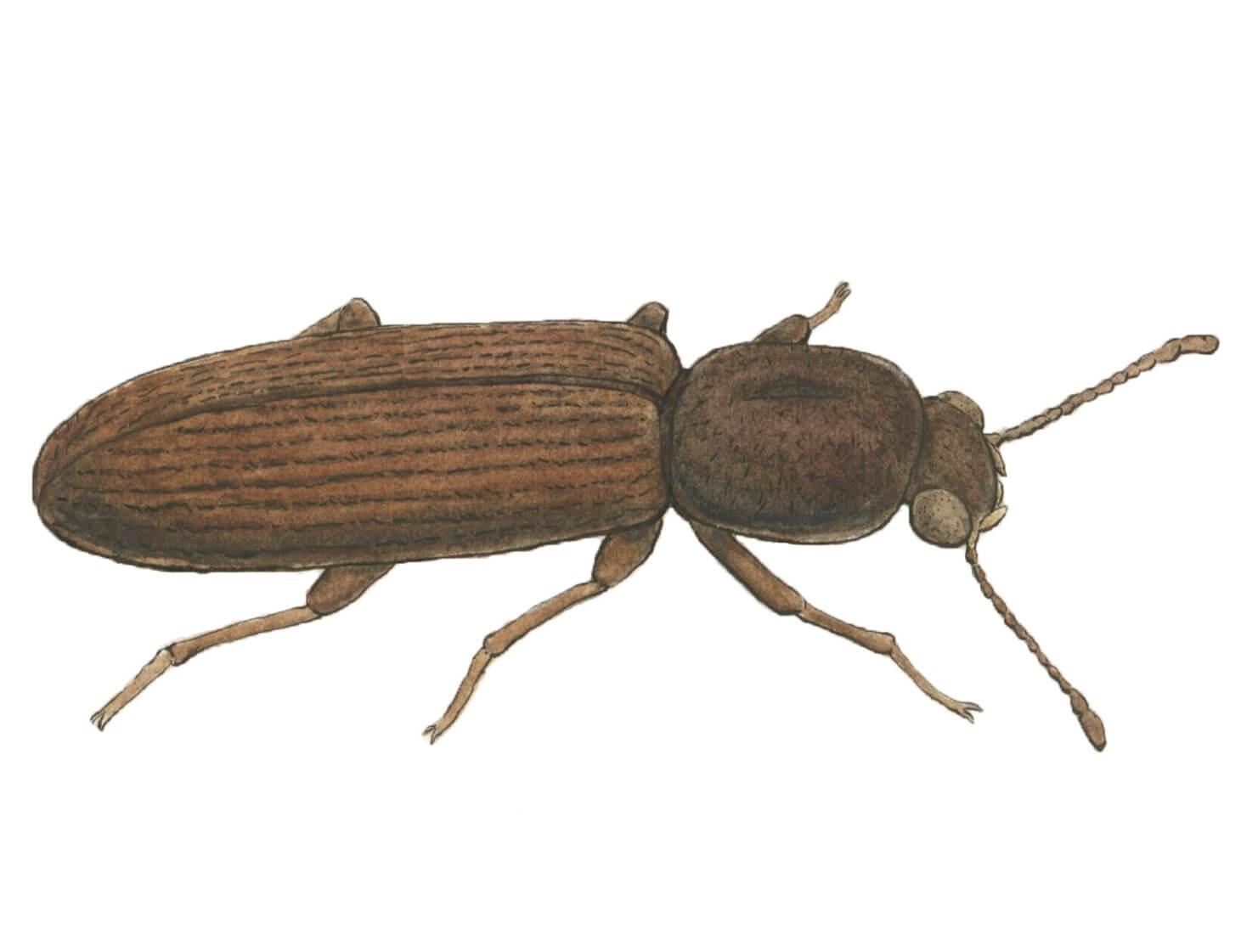
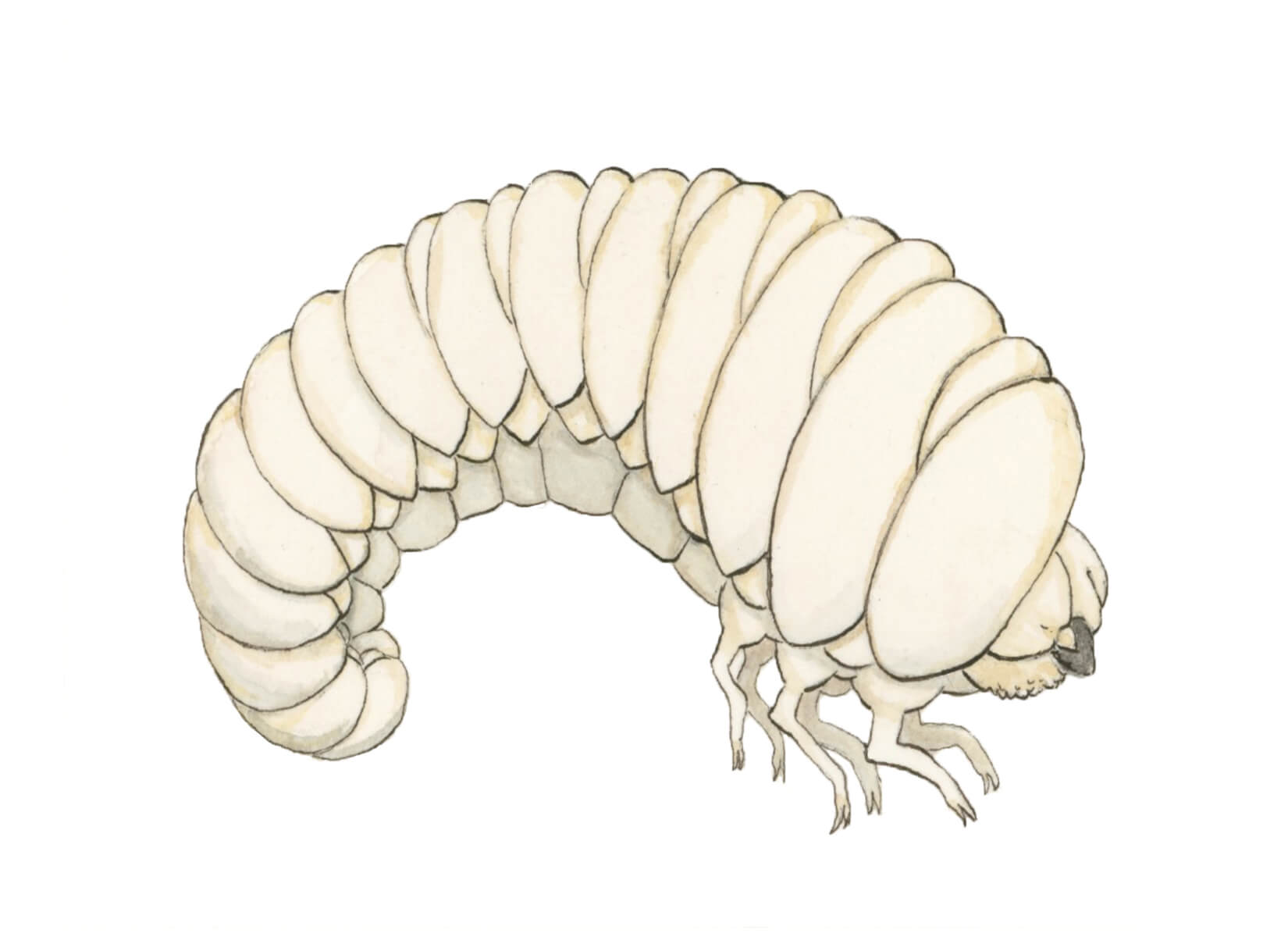
Look for Evidence
If you are concerned about whether your piece might be infested, there are three key elements for you to look for.
1- Flight holes: Perfectly round holes evident in wood support that measure in diameter from 1/32”-1/8” caused by a borer beetle exiting the wood to continue its life cycle.
When assessing your piece, the first sign of an infestation, whether previous or active, are flight holes. Also known as exit holes. There might only be a few holes or several. Often you will likely first find exit holes on unfinished areas of wood, such as the back of a frame, back, and the underside of the furniture, etc. However, exit holes can, at times, also be found on painted, varnished as well as gilded surfaces.
2-Frass: A fine dust or support material left behind from a feeding insect.
Once you have identified any flight holes, check for frass.
On the surface – Frass can be found on the surface of an object, or on the floor next to/underneath the piece. However, just because it is found on or nearby a piece does not necessarily mean that it is an active infestation. The item in question could have been moved and the frass could have been dislodged from old exit holes.
Review the flight holes – Check the edges of the flight holes for a fine coating of frass. Oftentimes, having a light film delicately laying along the edge of a flight hole is an initial sign of an active infestation.
3-Insects-Wanted Dead or Alive
Have you seen an increase in the activity of insects near the piece?
Alive – The first sign to look for is the presence of the beetle or its larvae. An adult measures approximately ¼” in length. Obviously, if you see adult beetles nearby, you are dealing with an active infestation. It is rare to see larvae in the environment outside of a piece since the larvae are usually burrowed within channels of the piece.
Spiders – While spiders aren’t wood borers and don’t cause a threat themselves, spiders eat other insects and would be attracted to any increased activity by the wood-boring insect.
Dead – Look for any dead insects or casings on the surface of the piece, or on the floor nearby. The adult could have exited the piece, or it could have been dislodged from a previous infestation.
3-Insects-Wanted Dead or Alive
Have you seen an increase in the activity of insects near the piece?
Alive – The first sign to look for is the presence of the beetle or its larvae. An adult measures approximately ¼” in length. Obviously, if you see adult beetles nearby, you are dealing with an active infestation. It is rare to see larvae in the environment outside of a piece since the larvae are usually burrowed within channels of the piece.
Spiders – While spiders aren’t wood borers and don’t cause a threat themselves, spiders eat other insects and would be attracted to any increased activity by the wood-boring insect.
Dead – Look for any dead insects or casings on the surface of the piece, or on the floor nearby. The adult could have exited the piece, or it could have been dislodged from a previous infestation.
Take Action
You don’t necessarily need to see insects firsthand, or a delicate dusting along the edge of a flight hole to take action.
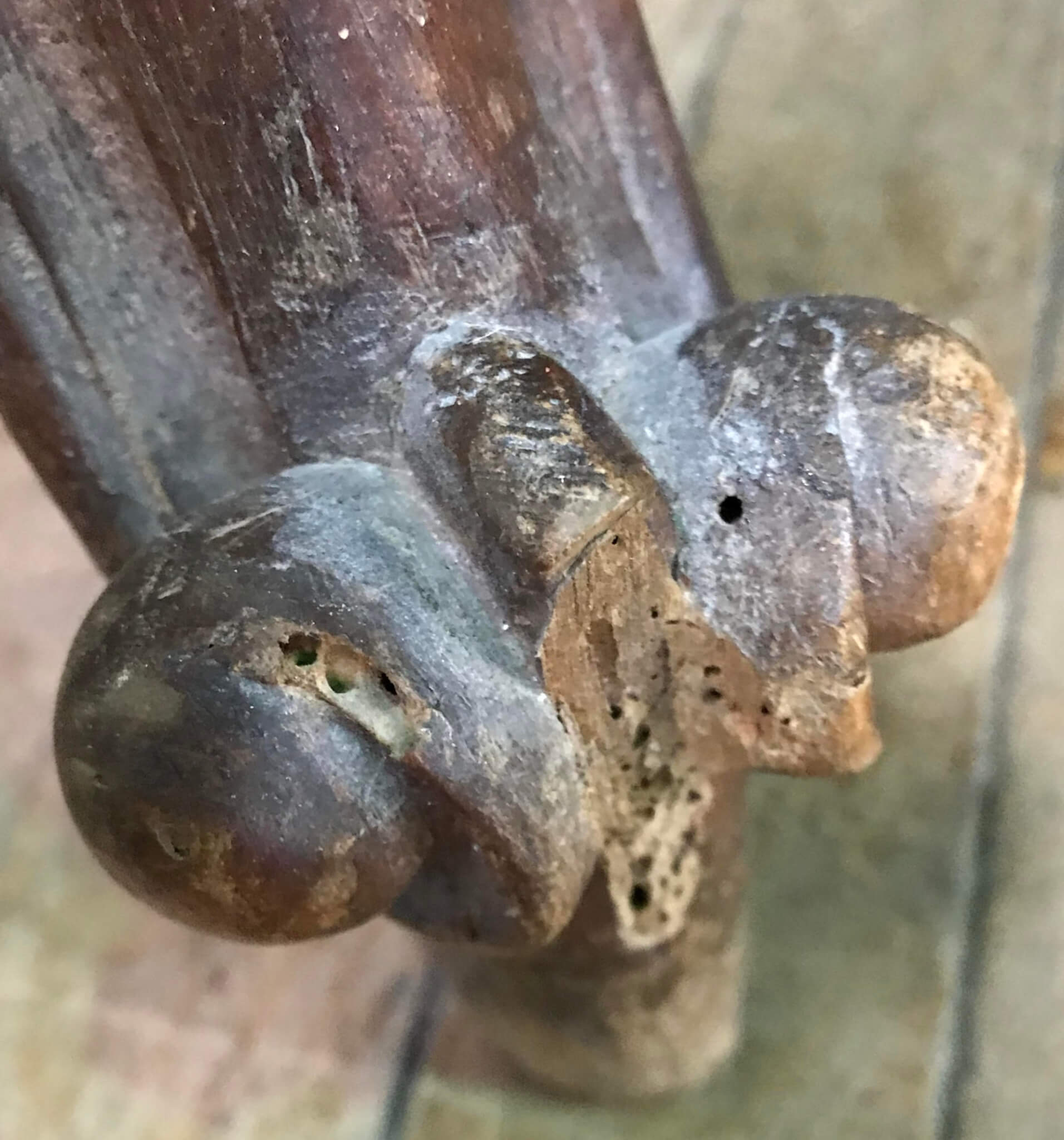
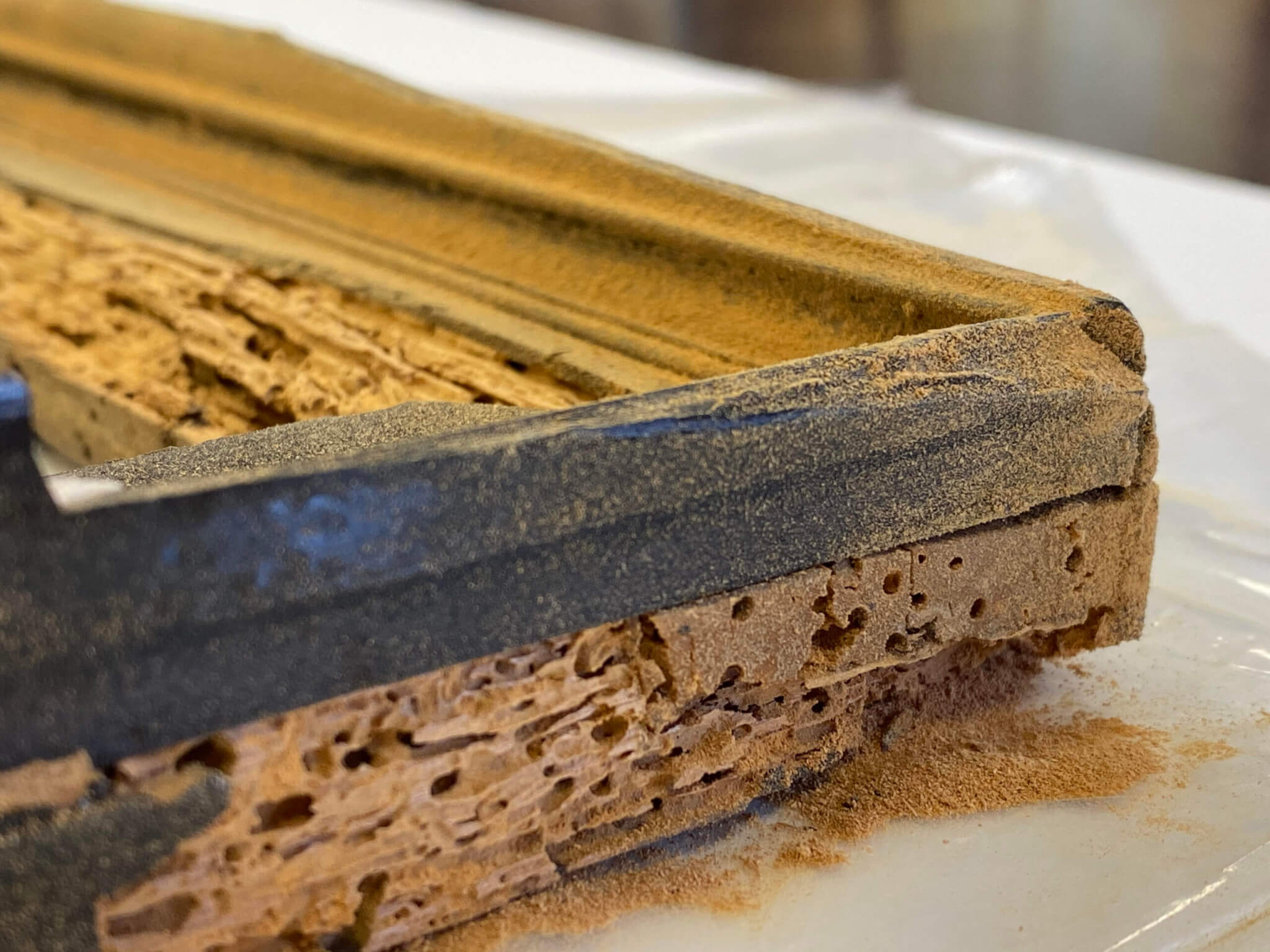
1- Gather Evidence
If you come across any insects or casings, dead or alive, retain them in a sealed bag for future reference. Even if you are convinced that the Powerderpost beetle is the culprit, it is best to review the suspect firsthand to confirm.
2-Review for Structural Stability
Given the nature of the infestation, if an insect is boring channels through wood, a lot of the damage that is potentially sustained is not even evident on the exterior of the piece. Check supporting elements to make sure that they are stable. If there are unstable or loose areas, carefully handle the piece to not cause further strain on the item. The image on the left illustrates a compromised foot of a chair from an insect infestation. The small exit holes are evident in several areas within the image.
3-Lightly Clean
Lightly clean the surface and the adjacent area to remove the loose frass. You want to remove the frass as safety permits because in the upcoming steps, it will help facilitate further observation of insect activity. The image on the right illustrates a severe example of infestation with the presence of frass.
4-Relocation and Quarantine
Relocation for Observation – If the infestation does not appear to be active, as a safeguard, you can relocate the item to another area, place it on a clean surface and observe it for the further presence of frass. Keep in mind that an infestation of one piece can spread to other wooden artifacts, for further safeguarding, you can also wrap a piece while it is undergoing observation to avoid the potential risk of other items in the environment.
Quarantine – If there is a concern that it is active, immediately isolate it from the environment and wrap it in plastic. Make sure that the piece is fully encapsulated and sealed to eliminate any risk of insects emerging from the wrapping.
If the activity involves a framed painting, the painting should be immediately removed from the frame. The frame and the painting should be individually wrapped and sealed, since their eventual treatment and exposure may differ.
Eradication
Addressing and exterminating these pests is not a one size fits all approach.
Each option has its advantages and disadvantages, depending on the nature of the exposure and the item that is affected.
A-Fumigation
Oftentimes this is the most expedient and cost-effective approach. Consult a specialist to determine if it is appropriate for specialty surface coatings and finishes.
B-Anoxic Treatment
The item is placed within an air-tight chamber. The oxygen is gradually depleted from the chamber. This is the most passive approach and is preferred since it does not expose the piece to chemicals. This approach is a gradual process and has the longest turnaround time for treatment. It is also difficult to treat large pieces, since they need to be contained within a chamber with an airtight seal, as well as, the larger the piece, the larger the chamber, and the larger the amount of oxygen in the containment that needs to be depleted.
C-Nitrogen/Argon Gas
The item is placed within an air-tight chamber. The oxygen is replaced with Nitrogen/Argon Gas within the chamber. The introduction of gas reduces the time required for treatment and does not leave a residue on the surface.
D-Freeze/Thaw Cycle
The item is wrapped, frozen, and then thawed. To ensure the infestation is eradicated, the cycle is often repeated. This treatment does not require exposure to chemicals, however, this process can lead to expansion and contraction of the piece during treatment. Since the item is placed in a freezer, that can also limit the size of the piece to be treated in this manner.
Final Steps
After the infestation has been successfully eradicated, the piece should be cleaned to remove any extraneous, frass, insect casings, etc. on the surface. Areas of structural instability should be consolidated and secured to ensure that the piece is not further compromised.
Assessing for exposure to determining the best approach for eradication, there are a lot of variables to consider. Eradication is not a one size fits all approach. It can be a delicate balance of the type of item, the timeline, and related costs that are involved with the care of an affected piece.
A conservator can help prescribe the best approach by assessing the extent of the exposure, as well as stabilizing the damage after the infestation is eradicated.
If a wooden artifact is properly cared for and stabilized after exposure, the evidence of flight holes is considered part of a piece’s patina, and evidence of age.
If you need assistance or have questions about an infestation, please feel welcome to contact us at:
312-344-0331
Our collection of educational articles about
custom framing, collection care, and emergency response are updated regularly.
Click on each topic below for a menu of corresponding articles.
Collection Care Articles
By April Hann Lanford
Our collection of educational articles provides an introduction to many topics about the preservation and conservation of fine art, antiques, and fine furniture.
Topics are often written as a result of questions provided by our clients.
Emergency Care Articles
By April Hann Lanford
Our emergency care articles are a helpful introduction to how to prevent damage through preventative measures or art and antique collections. When a disaster strikes, prompt response and taking the right steps can mitigate further damage.
Antique Trader Articles
By April Hann Lanford
Visit our collection of articles that have been published in Antique Trader.
antiquetrader
For more than 60 years Antique Trader has been inspiring, informing, and entertaining the collecting community with timely...
Projects
By April Hann Lanford
A selection of Artifact’s most recent projects highlighting our conservation and preservation work. We present each unique story describing the conservation process from reviewing the history, cause of loss, and condition to the steps of the treatment.
Glossary
A collection of art and conservation terms along with makers and firms compiled into a glossary and highlighted throughout our website for reference.
We are available to assist you
Main Location
840 N. Milwaukee Ave, Chicago IL 60642
Mon-Fri: 9:00 am - 5:30 pm
Sat: 10:00 am-4:00 pm
Sun: Closed
Complimentary parking is available in the loading zone in front of the building
We can also serve you by appointment at our other locations in the Chicagoland area.
Additional Locations
Schiller Park • Highland Park • Lake Forest • Lincoln Park • Nashville, TN
Copyright 2024, Artifact Services, LLC | An Artmill Group Company
